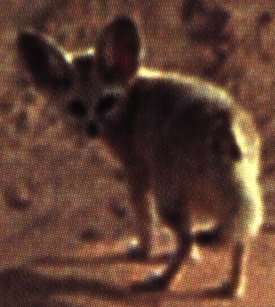

English Name:
-Fennec / Desert fox
Deutscher Name
-Fennek(auch Wüstenfuchs)
Group
-Vulpes (real foxes)
Lathin Name:
-Vulpes (Fennecus) zerda (recently reclassified from Fennecus zerda to Vulpes zerda)
appearance:
-rabbit-sized (smalest fox), very graceful. big eyes, long,(radar-)dish-like ears.
Tail nearly bodylong, fluffy. Fur soft, longhaired, topside yellow-sandcolored (nearly invisible on sand),
downside white (against color-difference through the shadow), braun-white Facemark. Tailend dark-brownish
-Males almost never weigh more than 3.3 lb (1.5 kg); vixens somewhat less.
-The ears, on the other hand, measure 6 in. (15 cm) or more, by far the
longest in comparison with other foxes. Ears and pointed snouts serve to
radiate heat. In addition to dryness, the environment is characterized
by remarkable differences in temperature during the day.
-Because of this extreme temperatures their paws are furred much like an arctic one's
-It don't have the scent-glads other foxes have. (That's why some people out there keep them as pets. :(( )
Geographic Range:
-Northafrica from Marokko to Ägypt and Northsudan, Arabia.
-mountainous and desert regions throughout North Africa, as well as in
the Sinai, and on the Arabian Peninsula
Habitat:
-deserts and half-deserts
Behaviour:
Activity: twilight- and nightactive. (But also seen at daytime)
- During the day the fennec usually stays in its widely branched subterranean
den, but even here needs protection from the heat, and like all canids,
it has no sweat glands. The bright color of the fur helps to control body
hear, but at night the denseness of such fine fur serves to help the animal
withstand the cold
-The activities of fennecs are nocturnal and seem to be instinctual.
-When keps in human care, they are also predominantly active at night.
This distinguished them from the red foxes, whose rythm is largely adapted
to human activity. Like all foxes, however, the fennec is easy to tame.
An acquaintance keeps several of them in his house and garden, although
this is not recommended for the fastidious. In any case, the animals adaptability
and playfulness are remarkable. Even in the wild, the fennec seems to prefer
to live in larger groups than is generally the case among other foxes.
Little is known of its behavior or ecology. It has been reported, however,
that several families sometimes live toghther in close proximity, sharing
their dens.
-From the fifth week onward, play in front of the den.
-Both parents participate in raising the young, sometimes with the assistance
of older siblings.
Reproduction
- Mating: Jan. and Feb.(Mar.-Apr.)
- birth after: 49-51 weeks (>50)
- birth-time: (Apr.)May.-Jun. (mostly May, if.cubs die quick second birth
possible till August.)
- litter size: 2-4 (rarely exceeds 5)
- whelps open their eyes between the 10th and the 14th day (and begin to
play four weeks)
- weaned after: 10-12 weeks (very long for foxes) (older facts (in human
care): (4)5-6 weeks ; meight be a sign of too big disruptance)
- grown up in: 9 month
Food Habits:
-Like all foxes, however, the fennec hunts alonem capturing primarily insects, reptiles and small mammals. It also consumes vegetation if available. It drinks available water, but is also able to survive for long periods on the water content of its food.
Specialities :
-existence in the wild localy in high danger,seldomly shown in Zoos.
others :
- The supportive capacity of the biotops is fully exploited; pronounced
deviations in population are rare. If the population does decline, for
example, as a consequence of human activity, recovery is slow. In this
they differ from many species in unstable ecosystems, which include the
Arctic fox. These animals can adapt quickly to those catastropheis commonly
occurring in their habitat, adjusting the number of their young to prevailing
conditions.
That number can range from zero to twenty. Such animals are opportunistic
in every way. The red fox stands somewhere between the two reproduction
strategies of the fennec and Arctic fox. Fennecs were once more or less
uniformly distributed throughout north Africa. Today, however, they are
widely hunted in some areas, without reason. They pose no threat to pets
or to human interests. With its low birth rate, it is particulatly susceptible
to hunting. In many areas of its former range, it has become quite rare
or even extinct, a sad fate for on animal that symbolizes, like few other
animals have, the sparse desert life.
Links
(dead link removed)